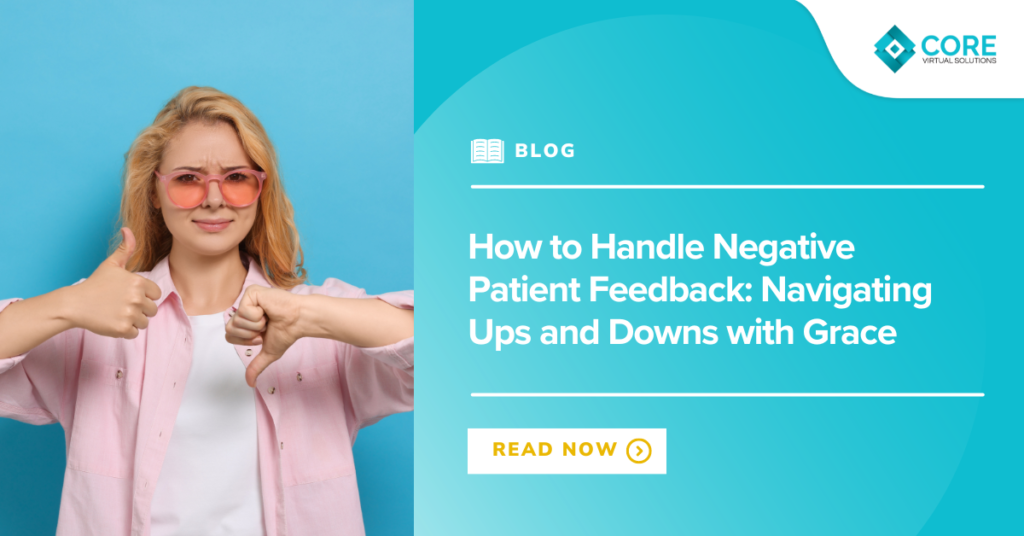As a practice owner, why do you need to learn how to handle negative patient feedback?
Mastering the art of handling negative patient feedback is a crucial skill for any healthcare worker, especially if you own your own practice. Negative feedback can be tough to hear, but it’s often a gold mine of insights that can help you improve your service. It gives you a window into the patient’s perspective, allowing you to identify gaps in your care that you might not have noticed. Moreover, how you respond to criticism can significantly impact your practice’s reputation.
Patients value healthcare providers who listen, show empathy, and are proactive in resolving issues. By handling negative feedback effectively, you show that you value your patients’ experiences and are committed to continual improvement. This not only helps retain existing patients but also attracts new ones, contributing to the growth and success of your practice. Remember, every piece of feedback, positive or negative, is an opportunity to learn and enhance patient satisfaction in your practice.
Try these tips and learn how to handle negative patient feedback!
 1. Actively listen to understand, not just respond.
1. Actively listen to understand, not just respond.
When faced with negative feedback, the inclination may be to respond immediately. However, active listening takes precedence. Understand the patient’s perspective, acknowledge their feelings, and resist the urge to defend. Listening fosters a genuine connection.
Remember that you are listening not just to have an answer or rebuttal to your patient’s feedback, whether it be negative or positive. Know that active listening is to understand and put yourself in their shoes to promote an effective conversation.
 2. Respond promptly and professionally.
2. Respond promptly and professionally.
Timeliness in response is crucial. Acknowledge the feedback promptly, expressing gratitude for the patient’s input. Craft a professional response that conveys a commitment to addressing their concerns. This shows accountability and dedication to patient satisfaction.
Taking too much time to respond with feedback may cause a feeling of neglect from the patient’s perspective. Also, choosing the proper responses during the conversation will help in maintaining the professional tone and flow of the conversation. Remember, a healthcare professional’s priority is patient care and this should radiate through your choice of responses.
 3. Avoid a defensive Stance. Be open to critique.
3. Avoid a defensive Stance. Be open to critique.
Defensiveness can create barriers to effective communication. Feeling the need to defend yourself once faced with negative feedback is human nature’s response whenever feel threatened. But keep in mind that the patient is coming from a place of disappointment and that the negative patient feedback is not directed to you on a personal level.
Instead, be open to critique. Acknowledge that feedback, even if negative, is valuable. Express a willingness to learn from the experience and make necessary improvements.
 4. Apologize sincerely for any inconvenience.
4. Apologize sincerely for any inconvenience.
If the negative feedback indicates an inconvenience or dissatisfaction, offer a sincere apology. Patients appreciate genuine expressions of regret, reflecting a humane approach to addressing their concerns.
As healthcare professionals, navigating these ups and downs shows your initiative to learn from your mistakes and make up for them. This also shows patients that their welfare is your priority, establishing better quality patient care.
 5. Investigate the root cause of the problem.
5. Investigate the root cause of the problem.
Don’t just address the surface issue; delve deeper. Investigate the root cause of the concern. Was there a breakdown in communication, a misunderstanding, or a system flaw? Understanding the root cause is essential for preventing similar issues in the future. Implement changes when appropriate.
Negative feedback should not just be acknowledged; it should catalyze change. Implement changes in processes, communication methods, or other aspects contributing to the negative experience. This proactive approach demonstrates a commitment to improvement.
 6. Educate Staff on Handling Feedback
6. Educate Staff on Handling Feedback
Handling patient feedback is a collective responsibility. Educate staff on effective ways to receive and respond to feedback. Establish protocols for documenting and addressing patient concerns across the healthcare team.
How your practice handles negative feedback should be consistent from receiving the patient up until they walk out the door. Conducting seminars discussing the right responses for these situations will benefit your practice in the long run and produce empathic healthcare workers.
 7. Maintain Patient Confidentiality in Responses
7. Maintain Patient Confidentiality in Responses
While responding to negative feedback, prioritize patient confidentiality. Avoid discussing specific details of the patient’s case in public forums. Offer to continue the conversation privately to address their concerns more thoroughly.
Continue to practice HIPPA under these circumstances. This shows patient consistency in your practice and will help in establishing better trust in the doctor-patient relationship.
Embrace the freedom to focus on what truly matters—patient care and well-being—while your virtual cohort meticulously manages the minutiae. Connect to a future where technology and compassion coalesce, making your practice a beacon of modern medical marvels. Unveil the potential of your professional journey, navigated by the precision and support of your dedicated Virtual Medical Assistant.
Navigate your practice with our Virtual Medical Assistants!
In the bustling corridors of healthcare, where every second pulses with purpose, our Virtual Medical Assistants stand as indispensable emissaries of efficiency. Tailor-made for healthcare workers who embody the soul of their practices, these digital dynamos streamline complex workflows, liberating practitioners from the drudgery of administrative anchors.
Discover the ultimate solution for streamlining your medical practice: our Virtual Medical Assistants! These professionals will also help you how to lead your team through challenging times. Our team of highly skilled Virtual Medical Assistants offers unparalleled care and assistance for both your patients and your practice. Say goodbye to extended wait times and limited availability, and say hello to personalized support. Our Virtual Medical Assistants can take care of all aspects of patient care, enabling you to prioritize your patients. Experience the transformative results firsthand–start by scheduling a short and quick consultation call with us by clicking here!









